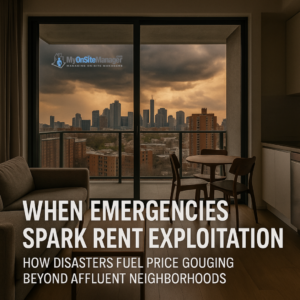When a wildfire rips through a community or a hurricane devastates a city, the immediate focus is on safety, survival, and rebuilding. Yet hidden beneath the headlines of destruction lies another, often overlooked consequence: skyrocketing rents.
Recent research has uncovered a disturbing trend rent hikes after declared emergencies are not confined to wealthy enclaves but are happening across working-class and middle-income neighborhoods. For renters already living paycheck to paycheck, these sudden surges can mean the difference between keeping a roof overhead and facing displacement.
The Study That Exposed the Problem
The Rent Brigade, a grassroots coalition of tenant advocates, researchers, and technologists, recently analyzed rental listings in Los Angeles following a January wildfire emergency declaration.
Their findings were eye-opening:
-
1,300+ potential cases of rent gouging were uncovered in just an 11-day window (January 7–18).
-
These listings involved 1,100+ landlords and real estate agents.
-
Collectively, the illegal increases represented $7.7 million per month in excess rent, or $92.4 million annually.
This wasn’t just a handful of bad actors it was evidence of systemic exploitation at a time when renters were most vulnerable.
Beyond the Wealthy Zip Codes
What made the findings especially alarming was the geography of the rent hikes.
While one might assume price gouging would target high-demand, high-income areas such as Malibu, the data showed otherwise. Rent surges appeared in working-class neighborhoods like Koreatown and Vermont Square, areas more than 15 miles from the fire zone.
In other words, even families living far from the disaster’s path were hit with sudden, inflated housing costs all because of the ripple effects of an emergency declaration.
Renters Fight Back With Data
Faced with this surge, renters didn’t remain silent. The Rent Brigade launched a crowdsourced spreadsheet to track suspicious listings, allowing residents to flag and share evidence of gouging.
The response was overwhelming. The document went viral, drawing thousands of contributions from renters, advocates, and watchdogs. By mobilizing digital tools, renters managed to shine a spotlight on what would otherwise have remained hidden behind closed doors.
Their grassroots organizing proved crucial in pressuring officials to act.
Law Enforcement and Local Response
The outcry prompted swift action:
-
California’s attorney general sent out over 650 warning letters to landlords and agents suspected of price gouging.
-
Criminal charges were filed against at least two realtors.
-
Locally, the Los Angeles County Board of Supervisors passed eviction protections for tenants displaced by the fires.
However, not all proposed protections passed. A broader rent freeze measure failed to secure approval at the city council level, leaving many renters exposed to unchecked increases.
A National Pattern of Post-Disaster Rent Spikes
What happened in Los Angeles is not unique. Research from institutions like Georgia Tech and the Brookings Institution reveals a recurring pattern across the U.S.:
-
Renters in disaster-affected areas face 4–6% rent hikes immediately after emergencies.
-
In communities frequently hit by disasters, long-term rent increases average 12% or more.
-
These rent hikes persist long after the disaster fades from headlines, compounding inequality and displacing vulnerable populations.
From hurricanes in the Gulf Coast to wildfires in the West, the story repeats: when emergencies strike, landlords raise rents and it’s renters who pay the price.
Why Disasters Create Rent Gouging Opportunities
Several factors explain why emergencies so often trigger rent inflation:
-
Reduced Housing Supply – When units are destroyed or damaged, fewer homes are available, pushing up demand for what remains.
-
Increased Demand From Displacement – Families forced from disaster zones often move to nearby neighborhoods, straining local housing markets.
-
Exploitation by Bad Actors – With demand spiking, some landlords and agents take advantage by inflating prices well beyond legal or fair levels.
-
Weak Oversight – Emergency declarations sometimes expand protections, but enforcement often lags, allowing illegal practices to go unchecked.
The result? Renters are squeezed at the exact moment when stability is most critical.
Policy Lessons and The Path Forward
To address this growing crisis, experts argue that policymakers must act decisively. Among the most pressing solutions are:
-
Stronger Enforcement of Anti–Price Gouging Laws
Local and state governments need to enforce existing protections more consistently, with harsher penalties for violators. -
Temporary Rent Freezes During Emergencies
Instead of allowing open-ended price shifts, emergency declarations should include temporary freezes to prevent landlords from taking advantage of vulnerable renters. -
Expanded Tenant Protections
Emergency eviction moratoriums, rental assistance programs, and relocation support should become standard practice after disasters. -
Support for Community Watchdogs
Groups like the Rent Brigade prove the power of grassroots data collection. Governments could collaborate with similar organizations to monitor and flag illegal activity. -
Funding for Recovery Programs
Federal tools like the Community Development Block Grant–Disaster Recovery (CDBG-DR) program, shown to ease rent pressures post-disaster, must be scaled up to meet growing needs.
Conclusion: Housing Stability as Disaster Preparedness
Disasters may be unavoidable, but housing exploitation is not. The surge in rent gouging after emergencies is a preventable injustice one that policymakers, communities, and tenants must confront head-on.
Without stronger protections, every declared emergency risks becoming a double crisis: one of natural disaster, and another of economic displacement. For renters, the fight is not just about recovery it’s about the right to remain in their homes.
Source
“Researchers uncover disturbing trend in rent prices after declared emergencies: ‘Not just in affluent areas’” – MSN
Read the full article here

